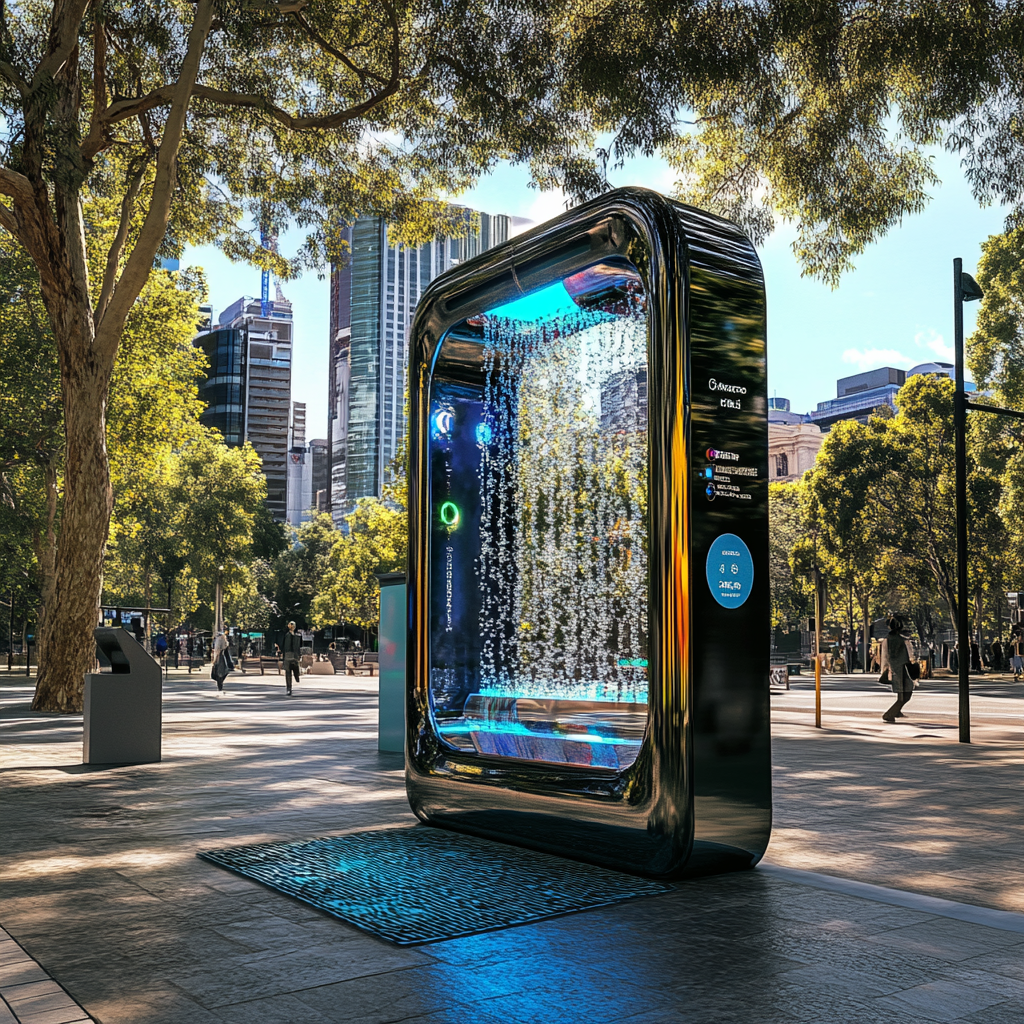Building on the atmospheric water generation (AWG) concept, our team advanced from early ideation into developing a speculative public solution – Aerozen, a solar-powered, AI-optimised public AWG hub designed for Melbourne’s 2050 urban infrastructure.
The idea emerged from a growing realisation: while a household unit addresses individual needs, Melbourne’s future water resilience demands accessible urban hydration infrastructure that supports equitable hydration, sustainable behavioural change, and trust in new systems.
Aerozen: A Speculative Public Water Generator
Aerozen is envisioned as a modular, aesthetically engaging community water hub that condenses moisture from the air, purifies it using advanced nanofiltration (including graphene oxide filters for PFAS removal), and delivers clean water on-demand to passersby. It operates off-grid via solar panels and uses AI-based climate adaptation to optimise water yield based on local humidity and air quality.

Key features as outlined in our concept presentation include:
- Touchless Water Dispensing: Using motion sensors for hygiene and accessibility.
- AI Display Interface: Provides real-time data on water quality, system status, and atmospheric conditions.
- Anti-Gravity Droplet Display Module: Communicates water purity and system trustworthiness through an intuitive, immersive visual.
- Decentralised Design: Units are deployable in parks, university campuses, transport hubs, and event venues.
- Quantum-Secure Data Management: Protects usage and sensor data, with user transparency and opt-in consent for research.
The user journey is illustrated through a hand-drawn comic (below), depicting a typical 2050 experience where a citizen approaches an Aerozen unit, engages via QR code, and participates in an ecosystem that donates water to drought-prone regions for every 50 litres used.

User Journey – Public Interaction in 2050
A typical interaction might involve a commuter walking through Federation Square on a hot summer day. They approach Aerozen, intrigued by the glowing interface. As they wave their hand near the sensor, a soft holographic display visualises their water being filtered in real-time, reinforcing transparency. They refill their bottle, while the interface invites them to scan a QR code to learn more about Melbourne’s climate resilience or earn water-saving rewards through gamified challenges.
Prototyping for Public Space
Initial public installation designs focus on cylindrical modular units using bio-based PLA or PHA, embedded with self-cleaning TiO₂ coatings for durability. These units are lightweight, low-maintenance, and adapted for Melbourne’s changing weather conditions.
A 2.7m-tall structure supports a touch-free refill point, solar roof panels, and a visual anti-gravity droplet display that doubles as a humidity sensor and data interface, making the infrastructure both functional and emotionally engaging for future city dwellers.



Next Steps – Decentralising Further: Household & Wearable Units
Recognising that not all users will consistently access public hubs, our next step is to develop miniaturised Aerozen systems for two additional contexts:
🏠 Household Version
A countertop AWG system that generates 5–10 litres per day, tailored for small apartments or off-grid households. Features include:
- Biodegradable housing.
- Smart water tracking via a companion app.
- Replaceable eco-filters with usage-based alerts.
Visual renderings below depict two conceptual aesthetics for household integration:
💧 Wearable Water Bottle Solution
A futuristic personal water bottle with embedded mini-condensation chamber and filtration membranes, ideal for cyclists, hikers, or urban explorers in low-water-access zones. Conceptualised as a self-sustaining unit that draws humidity while on the move, it includes:
- Solar nano-panel for power.
- Portable graphene mesh filtration.
- Embedded LED display for hydration tips and climate awareness.

Reflections and Future Work
The journey from the Purity Cube to Aerozen represents more than a technological evolution—it marks a fundamental shift from reactive problem-solving to proactive systems reimagining. What began as a solution to purify contaminated water has transformed into a broader vision: redefining how and where water is generated. This progression was guided by speculative design, participatory co-creation, technological benchmarking, and long-term sustainability foresight.
To translate this vision into reality, the following steps will guide the development of Aerozen’s final household form:
- Conduct user-centred research to understand household water behaviours, preferences, and barriers through surveys, interviews, and observational studies.
- Prototype and test compact Aerozen units tailored for domestic use, focusing on design integration, user interaction, and water generation efficiency.
- Establish technical and manufacturing partnerships to explore scalable, cost-effective production of household models.
- Develop an intuitive digital interface (mobile app or touch panel) with real-time feedback, maintenance alerts, and habit-forming features based on behavioural insights.
- Pilot early prototypes in selected homes, gather performance data, and iterate based on real-world usage and feedback.
In a future where water may become a scarce and valuable commodity, Aerozen repositions hydration as a public right—delivered through the integration of deep technology, environmental ethics, and inclusive design. Aerozen is not just a device; it is a narrative-driven system that brings together care, science, and imagination to shape Melbourne’s water futures.
Our use of the BJ Fogg Behaviour Model informed the design of its touchless interface and gamified reward system, helping lower engagement barriers and encouraging habitual use. Through this, Aerozen becomes not only a sustainable infrastructure solution, but also a catalyst for behavioural change in an increasingly climate-aware society


Recent Comments